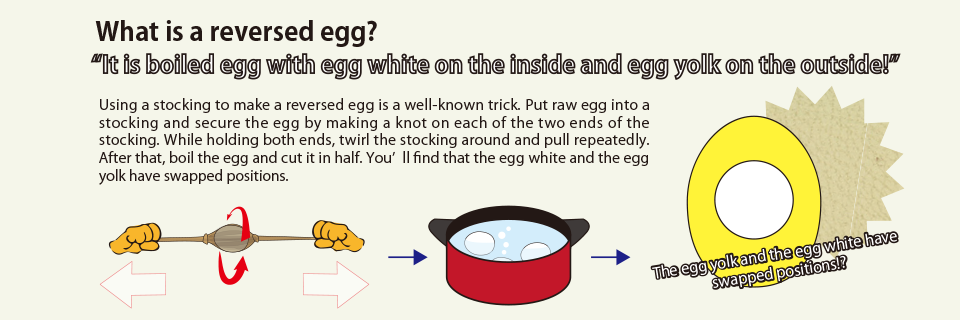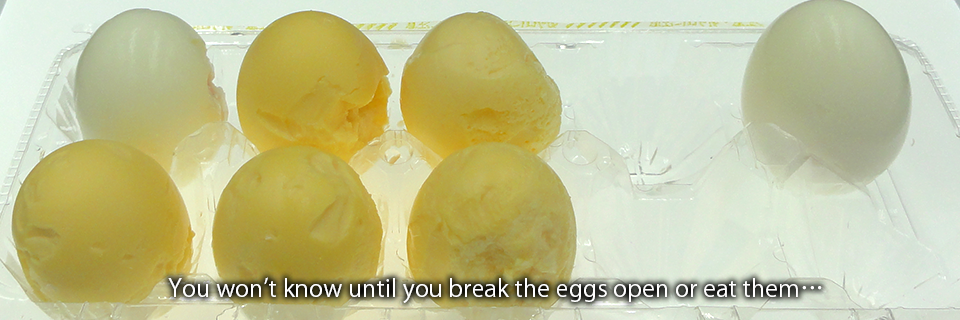We mixed this and that using THINKY MIXER: Raw Egg
July 19, 2019|Topic

We are pleased to share a new story in the “We mixed this and that using THINKY MIXER” series, which we haven’t done in a long while.
This time around, we agitated raw eggs using the Thinky Mixer ARE-310.
We used not cracked eggs but eggs with intact shells. So strictly speaking, we “agitated raw eggs,” didn’t we?
Taking up the challenge of reversing the egg yolk
Do you know a reversed egg (boiled egg with egg yolk on the outside and egg white on the inside), a science experiment that you can conduct at home?

Can we do this using the Thinky Mixer!? We gave it a try.
First and foremost, we had to make preparations.
Assuming that it would be better to have an adaptor so that raw egg does not break, we prepared a boiled egg case which is a container that you use when you pack boiled egg for mountain climbing or a boxed lunch.
We found a small gap at the top when we set the egg, so we filled it with bubble wrap (photos No.1 and No.2).

However, because we were unable to put the case into the Thinky Mixer as is, we put it in an adaptor that was designed for the Thinky Mixer ARV-50LED. The adaptor was a perfect fit, as if it were made especially for the egg case in terms of size (photos No.3 and No.4).

From a video showing how to make a reversed boiled egg, we estimated that the rotation speed was approximately 60 rpm.
So, we started off with the lowest rotation speed, that is, 400 rpm for 30 seconds.
When we cracked the rotated egg by way of trial, we found no change. We tried 1000 rpm for 30 seconds as well, but the egg yolk and egg white remained unchanged.
We increased the rotation speed to 2000 rpm for 30 seconds and 1500 rpm for 30 seconds, but some eggshells cracked.
The exceptional power of the Thinky Mixer must have been too much for the egg case.

In order not to break an egg…
If the egg breaks, we will not be able to make a boiled egg, let alone a reversed egg…
As the first step, we reinforced eggshell with scotch tape. We wrapped an egg up with scotch tape. Next, we wrapped it up in bubble wrap and set it in the egg case.
Some eggs did not break, but we discovered one egg that was pulled toward the lower part of the egg case, where it slipped through a gap of the bubble wrap, hit the egg case wall, and broke its shell.
This is exactly the first step of Thinky Mixer operations: place heavy things at the bottom and light things on top.
Next, we placed a sponge-type insulating material at the bottom of a 300 mL container to prevent the egg from being pulled downward and hitting the container bottom. Then, we wrapped an egg up in bubble wrap to fit the container snugly and placed it in the container.
Because the egg was wrapped up in bubble wrap securely and fit the container snugly, the egg did not break.

After agitation at 2000 rpm, the egg was boiled…
At 1500 rpm, we noted no yolk-white reversal, so we increased the rotation speed to 2000 rpm and increased the agitation time in phases.
We tested a total of nine eggs.
Eggs Nos. 3, 5, 6, 8, and 9 did not break and could be boiled.

Then, we boiled the eggs that were successfully agitated without breaking.
The state of the eggs is shown below:

No. 3: Normal boiled egg with no yolk-white reversal.

No. 5: Although it seemed to be beautifully reversed, when we cut the egg in half, the egg white appeared patchy.

No. 6: Nearly perfectly reversed!


Nos. 8 and 9: Despite the longer agitation time, they were not reversed and ended up as normal boiled eggs.
No. 10 is normal boiled egg that was boiled without agitation.

Results of 1st Experiment (Rotation speed: 2000 rpm)
| Egg Number | Placed Horizontally or Longitudinally | Agitation Time | State after Agitation | State after Boiling |
|---|---|---|---|---|
| 1 | Longitudinally | 60sec | Broken | × |
| 2 | Horizontally | 60sec | Chapped | × |
| 3 | Horizontally | 30sec+30sec | Success → boiled egg | Not reversed |
| 4 | Horizontally | 30sec | Chapped | × |
| 5 | Horizontally | 30sec+30sec+30sec+30sec | Success → boiled egg | Reversed |
| 6 | Horizontally | 120sec+60sec | Success → boiled egg | Reversed |
| 7 | Horizontally | 120sec+120sec | Broken | × |
| 8 | Horizontally | 120sec+120sec | Success → boiled egg | Not reversed |
| 9 | Horizontally | 120sec+120sec+60sec | Success → boiled egg | Not reversed |
| 10 | Not agitated → normal boiled egg | Not reversed | ||
Can we safely say that we succeeded in making reversed eggs for Nos. 5 and 6? Upon peeling off the eggshell, a yellow egg appeared. We cut it in half and saw something white on the inside. We couldn’t help but smirk.
Follow-up Experiment (Texture comparison)
Because we had many boiled eggs, we gave them away to people at our workplace. A few days later, someone mentioned that although the egg looked like a normal egg on the surface, it tasted differently, so we conducted a follow-up experiment to clarify the texture one week later.
Now that we had figured out how to set an egg in the container perfectly, we were able to agitate all the eggs without breaking any in the follow-up experiment.
This time around, we found a piece of information on the Internet stating that an egg that is not reversed allows light to pass through when irradiated, in contrast to a reversed egg. We found this information extremely useful that we should have tried this for egg Nos. 8 and 9 in the previous experiment. We urge you to do this if you don’t want to fail in making a reversed egg.

An egg without agitation (left), an egg after agitation for 120 sec (middle), and an egg after agitation for 180 sec
(Egg No. 3 and those beyond did not let light pass through, just like No. 2.)
Results of 2nd Experiment (Rotation speed: 2000 rpm)
| Egg Number | Placed Horizontally or Longitudinally | Agitation Time | State after Boiling/th> |
|---|---|---|---|
| 1 | Horizontally | 120sec | Not reversed |
| 2 | Horizontally | 180sec | Whole egg became yellow |
| 3 | Horizontally | 180sec+60sec | Whole egg became yellow |
| 4 | Horizontally | 180sec+120sec | Whole egg became yellow |
| 5 | Horizontally | 180sec+180sec | Whole egg became yellow |
| 6 | Horizontally | 120sec+60sec | Whole egg became yellow |
In this experiment, egg No. 1 was not reversed and all other eggs from No. 2 and beyond became yellow. There were no reversed eggs.

We compared their tastes!
Below is a summary of our impressions after comparing the tastes of eggs that were agitated and those that were not.
Eggs that were not reversed due to short agitation time
* Egg yolk and egg white seem cramped.
* Tastes like dried cheese
* Elastic
* Egg yolk tastes like yokan (sweet azuki-bean jelly) and egg white is slightly hard.
These are individual impressions; nevertheless, these impressions confirmed that agitating normal eggs would give rise to differences in taste.
Eggs that were reversed or became faintly yellow overall
* With a faint color, the whole egg looks like egg white
* The taste of egg yolk is difficult to discern
* An indescribable taste … the texture is egg white with a slight taste of egg yolk
* If you add sugar, it should taste like hard pudding
* It comes across as a boiled egg without a powdery texture
* It tastes like jelly and is interesting to the palate
* Tastes nearly egg white only
A reversed egg looked interesting on the surface but quite a few people said it tasted rather bad.
After the Experiments
To tell you the truth, when we saw the egg reversal method using a stocking, we presumed that the egg yolk would move toward the eggshell due to centrifugal force and that through the complex movements of the Thinky Mixer, no reversed egg would be formed and the whole egg would become yellowish. As it turned out, however, egg Nos. 5 and 6 in the first experiment became reversed eggs albeit being slightly patchy on the inside.

We assume that everyone knows that an egg is made of egg white and egg yolk, but its structure can be further broken down. Egg white is separated into the outer thin albumin, the inner thin albumin, the thick albumin, and the chalaza. When you beat an egg, what remains as a thick substance is the thick albumin.
Egg yolk is covered by the vitelline membrane. When a reversed egg is made, the vitelline membrane is broken and egg yolk liquid on the inside mixes with the thin albumin. When boiled in that state, it seems that the thin albumin part in which the egg yolk is mixed hardens first and the thick albumin that is heavy remains at the center, making the yolk-white swap possible.
As regards reversed egg Nos. 5 and 6, the vitelline membrane was broken as the eggs were agitated, and the thin albumin layer in which egg yolk was mixed and the thick albumin layer were well mixed.
In addition, we chose eggs that were as fresh as possible because these seemed to have hard eggshells that did not easily crack while being agitated. For this reason, we suppose that in the case of egg Nos. 8 and 9, the vitelline membrane was too fresh to be broken.
The eggs used in the second experiment were one week older than those in the first experiment. Because the eggs were less fresh, the thick albumin became watery and did not remain at the center, and all the eggs from No. 2 and beyond were believed to have ended up becoming yellow boiled eggs. The vitelline membrane also loses structural integrity as days go by.

Because of individual variability in raw eggs as the strengths of the eggshell and the vitelline membrane differed according to freshness or the age of chickens, we realized that you can’t win them all.
This time around, we set the agitation time from 30 to 180 seconds for a giggle, but with the Thinky Mixer, it can be set by the second. We were a bit disappointed that the eggs were not reversed due to the short agitation time, but saw the potential of creating a recipe to reproduce a reversed egg that tastes better, by setting the agitation time by the second without breaking the vitelline membrane.
You can enjoy boiled egg in a different way with a little bit of ingenuity.
It feels strange if you get a yellow egg upon breaking the shell.
Other than agitating at a high speed, there seems to be a different way to make a reversed egg by breaking the vitelline membrane.
Let me encourage you to try this as an independent research assignment for your kids during the summer vacation!
*Please note that the Thinky Mixer used in these experiments is specifically intended for foodstuff. Please refrain from agitating or eating eggs using a Thinky Mixer that is used for other materials or other purposes, such as research.